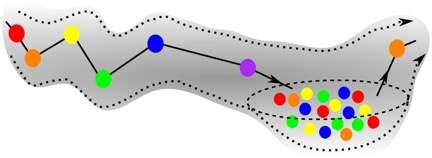New math model represents how mind processes sequential memory, may help understand psychiatric disorders

Try to remember a phone number, and you're using what's called your sequential memory. This kind of memory, in which your mind processes a sequence of numbers, events, or ideas, underlies how people think, perceive, and interact as social beings.
"In our life, all of our behaviors and our process of thinking is sequential in time," said Mikhail Rabinovich, a physicist and neurocognitive scientist at the University of California, San Diego.
To understand how sequential memory works, researchers like Rabinovich have built mathematical models that mimic this process. In particular, he and a group of researchers have now mathematically modeled how the mind switches among different ways of thinking about a sequence of objects, events, or ideas, which are based on the activity of so-called cognitive modes.
The new model is described in the journal Chaos, from AIP Publishing, and it may help scientists understand a variety of human psychiatric conditions that may involve sequential memory, including obsessive-compulsive disorder, bipolar, and attention deficit disorder, schizophrenia and autism.
Cognitive modes are the basic states of neural activity. Thinking, perceiving, and any other neural activity incorporates various parts of the brain that work together in concert. When and where this activity occurs takes on well-defined patterns. And these patterns are called cognitive modes.
To understand what the researchers modeled, Rabinovich explained, think of the modes as competing figure skaters. You can describe the skaters in three ways. First, you can consider their backgrounds: their names or where they come from. You can also describe the technical aspects of their performances—how well they did that triple-toe-loop, for instance. Finally, you can understand their skating from a purely emotional or aesthetic perspective: their facial expressiveness, their costumes, or the simple beauty of movement. To fully comprehend the skaters, you have to constantly switch among these three perspectives. When these perspectives describe cognitive modes, they're called modalities.

When the mind has sequential thoughts, the cognitive modes underlying neural activity switches among different modalities. This switching is called a binding process, because the mind "binds" each cognitive mode to a certain modality.
In the new analysis, Rabinovich worked with Valentin Afraimovich and Xue Gong, mathematicians at the Autonomous University of San Luis Potosi in Mexico and Ohio University, respectively.
The mathematicians proved a theorem to show that in their model, this binding process is robust and able to withstand perturbations from the random disturbances in the brain. Your mind is full of other irregular neural signals—from things like other neural processes or external, sensory stimuli and distractions—but if they're not too big, they don't change the thinking process.
This model could be used to better understand a variety of psychiatric disorders, such as obsessive-compulsive disorder, bipolar disorder, and attention deficit disorder, Rabinovich said. The way the mind binds to different modalities, and how such binding depends on time, may be related to conditions such as autism and schizophrenia. For example, some experiments suggest that for people with these conditions, the capacity of sequential binding memory is smaller.
More information: Valentin Afraimovich et al. Sequential memory: Binding dynamics, Chaos: An Interdisciplinary Journal of Nonlinear Science (2015). DOI: 10.1063/1.4932563
Journal information: Chaos
Provided by American Institute of Physics



















